

Science of Bread: Basic Sourdough Starter Recipe. Science of Bread: Berkeley Sourdough Bread. Easy Beginners Bread – Recipe for Easy Beginners Bread. Updated October 25, 2016.
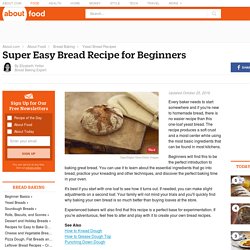
Every baker needs to start somewhere and if you're new to homemade bread, there is no easier recipe than this one-loaf yeast bread. The recipe produces a soft crust and a moist center while using the most basic ingredients that can be found in most kitchens. Beginners will find this to be the perfect introduction to baking great bread. You can use it to learn about the essential ingredients that go into bread, practice your kneading and other techniques, and discover the perfect baking time in your oven. Baking tips: Bread Troubleshooting. How to Make Easy Sourdough Bread. Sourdough simply uses wild yeast in place of commercial yeast to leaven the bread.
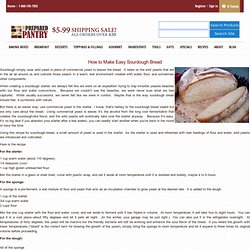
It relies on the wild yeasts that are in the air all around us and cultures those yeasts in a warm, wet environment created with water, flour, and sometimes other components. When creating a sourdough starter, we always felt like we were on an expedition trying to trap invisible yeastie beasties with our flour and water concoctions. Because we couldn't see the beasties, we were never sure what we had captured. While usually successful, we never felt like we were in control. Maybe that is the way sourdough bread should feel, a symbiosis with nature. But there is an easier way: use commercial yeast in the starter. High Gluten Flour or Vital Wheat Gluten?
So what's the difference between Bread Machine Flour, High Gluten Flour & Vital Wheat Gluten Flour?
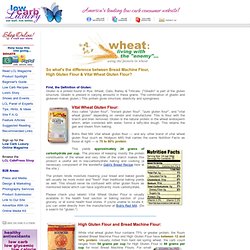
First, the Definition of Gluten: Gluten is a protein found in Rye, Wheat, Oats, Barley & Triticale. ("Gliadin" is part of the gluten structure. Gliadin is present in varying amounts in these grains. Slow-Rise, No-Knead Cinnamon-Raisin Bread Recipe Details. Make Your Own Sourdough Starter. If you’re feeling a bit adventurous, you may want to try creating your own sourdough starter from scratch.
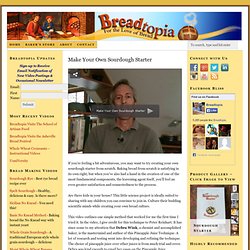
Baking bread from scratch is satisfying in its own right, but when you’ve also had a hand in the creation of one of the most fundamental components, the leavening agent itself, you’ll feel an even greater satisfaction and connectedness to the process. Are there kids in your house? This little science project is ideally suited to sharing with any children you can convince to join in.
Culture their budding scientific minds while creating your own bread culture. This video outlines one simple method that worked for me the first time I tried it. As I mention in the video, the wild yeast spores and lactic-acid bacteria that give your starter its leaving properties are all around you. I’ve listed the ingredients and approximate steps here to save you the note taking.
Step 1. TMF: baking bread / Living Below Your Means. Katie’s Basic Bread Baking Techniques (or lack thereof) Welcome!
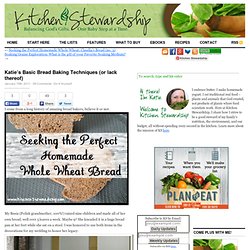
If you wish you could eat more whole foods without breaking your budget, you're in the right place. Start here for my top 10 baby steps to better Kitchen Stewardship. You might also be interested in family-friendly, delicious and nutritious recipes or one of my popular eBooks to help you on your journey. I come from a long history of amazing bread bakers, believe it or not. My Busia (Polish grandmother, 100%!) The white stool is on the right side of this photo, and that humongous, wide wash tub on top is the bread pan! My maternal grandmother also does a great deal in the kitchen, and one of her specialties is homemade pasta. Her mother-in-law was the sort to grab a bag of flour and tip some into the bowl, just eyeing up every single ingredient. The Minimalist - The Secret of Great Bread - Let Time Do the Work.
FAQs on Whole Wheat Bread Baking. FAQs on Whole Wheat Bread Baking Crystal Miller One of the most common emails I get is from ladies who are having some sort of difficulty with their bread baking.

I thought I would take these types of questions this month and focus on some of the problems, there causes and possible solutions. Bread baking is complex in all the components involved in making it and I believe it is an art that takes time to develop. Unlike other recipes where it is simply a matter of following the recipe amounts and baking, bread requires a knowledge of what is happening in the process as well as knowing and understanding key components such as kneading, rising, temperatures, etc.. The Wednesday Chef: Jim Lahey's No-Knead Bread.
I imagine many people's weekends were spent like mine - with a bowl of flour, instant yeast and water fermenting in a warm corner of the kitchen as they went about their business, courtesy of Jim Lahey and that kitchen imp, Mark Bittman.
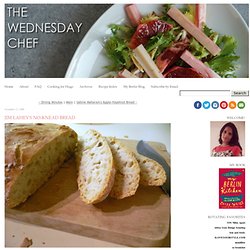
Yes, you all know how I feel about the Minimalist. I usually downright ignore his column when Wednesdays roll around. But this time, I simply could not. I've spent too many Saturdays lingering around Sullivan Street Bakery, gnawing on a slice of the best pizza bianca to be found in New York or walking back home with a crinkly bag of filone to ignore Jim Lahey's spectacular recipe for bread that is the easiest I've ever tried, with among the best results. Yes! It's so easy - you mix together some instant yeast, flour (I used a mix of bread flour and AP flour, half and half) salt and some water to form a "shaggy" dough. You have to let it cool before slicing, but when you do, beware. The Minimalist - The Secret of Great Bread - Let Time Do the Work. Amazing Artisan Bread for 40 Cents a Loaf - No Kneading, No Fussing, No Kidding. Update: If you're interested, I've written an update on this technique here.

What if I told you that instead of buying bakery bread for four or five dollars a loaf, you could make delicious handmade bread whenever you wanted, at a fraction of the cost and it is so easy a kid could do it? Well, read on because this method of making artisan bread at home will change your life. You can make incredible bread without having to do all the usual time consuming tasks of breadmaking : no need to make a new batch of dough every time you want breadno need to proof yeastno need to make starters or prefermented doughno kneading! In the last few years, several methods for making easy no-knead bread doughs have crept up on the internet and gained popularity. "The results have forced me to reconsider all of the premises I once held sacrosanct". So what is going on here?
Boules Rising and Boules after Baking To see how easy it is to get a loaf ready, you can watch me form a loaf in about 30 seconds: 1. 2. 3. Grain Blog » Blog Archive » Bread Flour vs. All-Purpose Flour – Answer to Kim’s Question. Missing or Broken Files When you get a 404 error be sure to check the URL that you are attempting to use in your browser.This tells the server what resource it should attempt to request.

In this example the file must be in public_html/example/Example/ Notice that the CaSe is important in this example. On platforms that enforce case-sensitivity example and Example are not the same locations. For addon domains, the file must be in public_html/addondomain.com/example/Example/ and the names are case-sensitive. How to Breads! Olive Nut Spread from Heloise Cruse. Flour + Water = Starter. Ah, summer… corn on the cob, lazy reading in the hammock, and… sourdough starter, of course!

I’ve been taking advantage of this warm weather to try raising some starters from scratch. I had done it before in a week-long class (in fact, that’s the starter I’ve been using for months), but we were able to keep our cultures at a constant 80 degrees F, and we added extra malt to jump-start the process. I wanted to see how it worked with just flour and water, in the warm but fluctuating room temperatures of my non-air-conditioned house in these beautiful early summer weeks in northern California. Success! Raising a starter seems to be something that is perceived as mysterious, complicated, or hard. I did this a couple of times, once with rye and once with whole wheat flour. Ready to try it? Recipe Index. Recipe - Gabi's World-Famous Bread. 1 pkg dry yeast (Rapid Rise/Highly Active) 1/2 teaspoon sugar * 1 1/8 cup "baby bottle warm" water (90-100°F) 3 Tablespoons olive oil 1 1/2 teaspoons baking powder 1 teaspoon salt 1 Tablespoon Splenda 1 cup vital wheat gluten flour 1/4 cup oat flour 3/4 cup soy flour 1/4 cup flax seed meal 1/4 cup coarse unprocessed wheat bran Pour yeast into bottom of bread machine pan.
Add sugar and water. Stir, and let sit. (This is "proofing" your yeast to see if your yeast is alive. If it's not bubbling, it's dead and you can replace it without wasting all of the other ingredients). In the meantime, mix all other dry ingredients together in a bowl. Cool on a rack and enjoy. * The sugar is totally consumed by the yeast and does not contribute to the carb count. Makes 16 slices. 3.4 grams net carbs per slice. ADDITIONAL NOTE FROM LORA: The above basic instructions are Gabi Moeller's original ones. Follow the recipe in the same order as for the bread machine. Steve's high-protein, high-fiber, low-carb bread.
I've enjoyed baking bread for twenty years, and expected to really miss it when we started low-carbing in April 2003. As soon as we got past the two-week "induction" phase, I started experimenting with ingredients, and after much trial and error, came up with the following, which tastes good, not at all like sawdust slices well: if you wish, you can slice it as thin as 1/3" without it falling apart contains no "weird" ingredients has about 9 g protein, 7 g carbs, 2 g fiber, and 3 g fat per normal-sized slice has a reasonable bread texture, albeit a little spongier than you're expecting, and did I mention, tastes good?
So here we go. The following makes 4 loaves, each a little under a pound and a half: I usually freeze one loaf's worth of dough for pizza, freeze one of the baked loaves, and eat the other two over the course of a week.